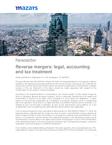
Reverse mergers: legal, accounting and tax treatment
Through Official Letter 220-056752 of March 29, 2016, the Superintendence of Companies made an analysis of the legal and accounting treatment of the reverse merger, even going into a little bit into the tax framing of the figure within the tax regime of business reorganizations. Nevertheless, a deeper analysis of the tax treatment of this figure should be made, especially with respect to the compensation of tax losses in merger processes.
According to the Superintendence of Corporations, the reverse merger "is that vertical merger by which a subsidiary absorbs its parent company, which is dissolved, transferring all its assets and shareholders or partners to the latter, which succeeds it in all its rights and obligations". In other words, it is the process of absorption by a subsidiary of its parent company, which is extinguished after such operation. Since there is no legal restriction or prohibition that prevents its execution, it is feasible to carry out this type of operation as long as the requirements and conditions for it are complied with, such as obtaining prior administrative authorizations when applicable.
From an accounting point of view, according to Memorandum N. 300-000230 of March 17, 2016, the Superintendency indicated that the merger by virtue of which a subordinated company absorbs its parent company holder of 100% of its shares "is not subject to a special accounting treatment". In its opinion, it is noteworthy "that the shares of the absorbed company in the absorbing company will be cancelled with a neutral effect on its capital and must be reissued again in favor of the shareholders of the absorbed company in the same proportion that they had in the absorbing company, unless the associates unanimously agree on a different distribution".
In tax matters, since related entities participate in the same operation, this is characterized as a "Re-organizational" merger in the light of the provisions of Article 319-5 of the Tax Statute. The complexity in the tax treatment of this figure arises when the subsidiary intends to offset the losses of the parent company, since article 147 of the Tax Statute indicates that it may do so "up to a limit equivalent to the percentage of participation of the assets of the merged companies within the assets of the absorbing or resulting company".
This rule, which is not part of the corporate reorganization regime established in articles 319 and following of the Tax Statute, makes sense in the case of acquisitive mergers, but it should be inapplicable in the cases of organizational mergers, especially in the case of reverse mergers, since in the end, the loss is only one for both entities and it makes no sense whatsoever that it can be limited by virtue of the merger.
It is worth mentioning that if the losses were those of the subsidiary, the aforementioned limitation would not apply, since they would be its own losses and not losses incorporated by virtue of the merger process.


